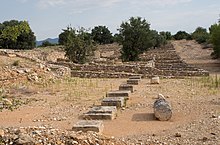Ὀλυνθος | |
 Bouleuterion of ancient Olynthus | |
| Location | Olynthus, Central Macedonia, Greece |
|---|---|
| Coordinates | 40°17′46″N 23°21′14″E / 40.296°N 23.354°E |
| Type | Settlement |
| Part of | Chalcidian League |
| Length | 1500 |
| Width | 400 |
| Area | 60 ha (150 acres) |
| History | |
| Founded | 7th century BC |
| Abandoned | 318 BC |
| Site notes | |
| Archaeologists | David Moore Robinson, Mary Ross Ellingson |
| Condition | Ruined |
| Ownership | Public |
| Management | 16th Ephorate of Prehistoric and Classical Antiquities |
| Public access | Yes |
| Website | Hellenic Ministry of Culture and Tourism |
Olynthus (Ancient Greek: Ὄλυνθος Olynthos, named for the ὄλυνθος olunthos, "the fruit of the wild fig tree"[1]) is an ancient city in present-day Chalcidice, Greece. It was built mostly on two flat-topped hills 30–40m in height, in a fertile plain at the head of the Gulf of Torone, near the neck of the peninsula of Pallene, about 2.5 kilometers from the sea, and about 60 stadia (c. 9–10 kilometers) from Poteidaea.[2][3]
The city flourished between 432 BC and its destruction by Philip II of Macedon in 348 BCE. It was finally abandoned in 316 BCE. Excavations were conducted across four seasons, spanning from 1928 to 1938.[4] Artefacts found during the excavations of the site are exhibited in the Archaeological Museum of Olynthos.
- ^ Liddell-Scott-Jones s.v. ὄλονθος.
- ^ Borza, E., M. Willoughby, R. Talbert, J. Åhlfeldt, J. Becker, A. Rabinowitz, T. Elliott, DARMC, J. Bartlett, S. Gillies (22 December 2021). "Places: 491678 (Olynthos)". Pleiades. Retrieved September 13, 2014.
{{cite web}}: CS1 maint: multiple names: authors list (link) - ^ W. Smith. 1854. "Olynthus." Dictionary of Greek and Roman Geography http://www.perseus.tufts.edu/hopper/text?doc=Perseus%3Atext%3A1999.04.0064%3Aalphabetic+letter%3DO%3Aentry+group%3D3%3Aentry%3Dolynthus-geo
- ^ Gates, Charles (2011). Ancient cities: the archaeology of urban life in the ancient Near East and Egypt, Greece and Rome (2nd ed.). London: Routledge. pp. 278–279. ISBN 978-0-203-83057-4.

